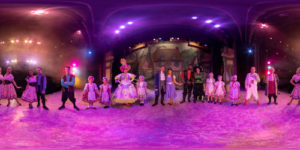
Just how did the British tradition of pantomime come about?

Image credit: Duncan Cuthbertson/Shutterstock.com
The great British tradition of pantomime usually takes place all across the country in the run-up to Christmas. The farcical slapstick plays are nearly always a comedic take on some of the most well-known children’s stories. Some of the most popular pantomimes include the likes of Peter Pan, Aladdin, and Cinderella. The comedic plays can be staged in some of the country’s swankiest theatres and may star well-known celebrities. Conversely, there are always plenty of small amateur productions that take place in remote village halls. However, one similarity between all productions is almost guaranteed – they will all play to a full house!
What is Pantomime?
Pantomime relies heavily on audience participation and good interaction with the players. The audience is encouraged to ‘boo’ the villain and shout out warnings to the protagonist, whenever it’s required. The familiar phrase in this respect is “He’s behind you!”, where ‘he’ refers to the villain. Traditionally, the pantomime always has a Dame character, who is always a man. Another ever-present character is the Principal Boy, who is always played by a girl.
The slapstick in every panto always includes plenty of custard pie-throwing and highly exaggerated acts of falling over. Ridiculous costumes and lots of corny jokes are also a mandatory part of the fun performances. However, no matter which pantomime is being performed the basic storyline is inevitably always the same. The villain is defeated, the protagonist finds true love and everyone lives happily ever after. So, just where did the silliness and absurdity of the pantomime come from?
Origins of Pantomime
Pantomime is usually viewed as something that is a wholly British affair. However, this turns out to be very much not the case. The word ‘pantomime’ is derived from the Greek word pantomimos. The ‘panto’ part means ‘all’, and ‘mimos’ means a ‘dancer’. Thus, the original meaning of pantomimos meant a performance by a dancer who acts all the roles in the story. Essentially, pantomime has its origins in the 16th-century Italian street theatre known as ‘Commedia dell’arte’.
Small touring companies would often set up in marketplaces and fairgrounds, across Italy and France. They would tell stories of the old man, Pantalone; the clown, Pierrot; the dreamy teenage girl, Columbine; and naughty servant, Arlecchino. The stories always featured lovers, magic, pursuits, and acrobatics. From the late 1600s, the same characters began to appear in English comic plays. The star of the show was the acrobatic, Harlequin, the anglicised name for the Commedia dell’arte’s Arlecchino.
Known as Harlequinades, the plays were the earliest form of pantomime but essentially followed the same formulae as that of their original Italian counterpart. The stories involved lovers, magic, chases, and acrobatics, with the Harlequin using ‘slapstick’ to essentially steal the show. In the late 1700s, actor Joseph Grimaldi, perhaps the best-known exponent of the art form, raised the profile of Harlequinades to new heights.
The Christmas Connection
By Victorian times, pantomime had become a typical Christmas affair. Witty scripts were adopted to put a comic twist on well-known stories like Robinson Crusoe which would also include humorous topical content. Even by this time, it was already cast in stone that the ‘Principal Boy’ would be played by a woman.
The end of the 19th century saw the rise of Music Hall and the demise of the traditional Harlequinade. However, pantomime adapted to changing times. Prominent entertainers crossed over to pantomime from variety, bringing with them topical comedy and popular songs of the day. In the 1930s and 1940s, popular radio personalities began to appear in pantomime, maintaining their popularity. Today, well film and tv stars, sports celebrities, and even ex-politicians, are ever ready to take up the pantomime mantle. In other words, pantomime is just as well-received today as it’s ever been.
You are also likely to find British-style pantomime in countries with particularly strong links to the UK. These include the likes of Ireland, Australia, Canada, and South Africa.
Header image credit: Brian A Jackson/Shutterstock.com
If you’ve enjoyed reading this post, why not check out more of the articles in the series by clicking the following link: Why do we…….?





